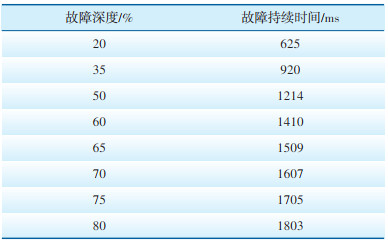2. 内蒙古电力(集团)有限责任公司,呼和浩特 010010
2. Inner Mongolia Power(Group) Co., Ltd., Hohhot 010010, China
近年来,国家提出2030年实现“碳达峰”、2060年实现“碳中和”的重大战略目标,构建以新能源为主体的全新型电力系统被视为实现双碳目标的重要途径,风力发电作为较成熟的新能源产业,得到大规模发展[1-6]。但随着接入电网的风力发电场及风电机组的数量增多,其自身的不稳定性给电网带来了新的挑战,尤其是当电网内的风力发电占比较高时,电网的扰动可能会导致风电机组的大面积脱网,进而扩大事故范围、造成严重的经济损失[7-11]。因此,国标要求并网风电机组应具备故障电压穿越能力,并在电网故障期间向电网提供无功电压支撑,保证整个电力系统的稳定[12]。此外,随着大电网仿真技术的不断发展,仿真的结果已能够向电网调度部门提供一定的决策支撑[13-16],因此很多地区电网也要求并网的风电机组应能提供与本机实际故障穿越特性相符的模型[17]。其中,风电机组的机电暂态模型主要基于美国PSD-BPA软件(简称BPA)进行构建。中国版BPA由中国电力科学研究院引进并不断完善,可满足电网的潮流计算、暂态稳定计算、短路计算等需求[18]。
准确的风电机组机电暂态模型是保证大电网仿真结果精准可用的基础[19-20]。在BPA中,风电机组模型是否准确取决于其在故障期间的控制模式是否准确[21-24]。部分型号双馈风机虽然具备故障穿越能力,但其故障期间的控制模式却无法与厂家提供的参数对应,因此对建模造成了极大阻碍。针对上述问题,本文以某型号双馈风电机组为研究对象,对其控制器进行了硬件在环测试,得到不同电压跌落深度下的故障穿越特性,并进一步分析其故障期间的有功和无功控制模式,辨识其控制参数,为精确建立机电暂态模型提供了重要依据,确保模型满足电力系统仿真需求,提高新能源消纳能力和电网安全稳定运行水平。
1 双馈风电机组仿真模型关键参数某风电场使用单机容量为5.2 MW的双馈风电机组,为了对该风电机组开展精确建模及参数辨识仿真分析工作,介绍该机组仿真模型和控制原理,以及机组故障穿越仿真分析时涉及的关键参数。
1.1 仿真模型和控制原理双馈风电机组通过功率变流器来实现电网电气频率与转子机械转矩解耦,进而实现动态控制和变速运行[25-27]。动态控制包括网侧变流器控制和机侧变流器控制[28-29]。其中,网侧变流器控制用于输出网侧变流器的有功和无功电流指令,有功电流指令用于控制直流侧电容和电压恒定,无功电流指令用于控制网侧变流器发出的无功功率,一般设置输出为零[30]。机侧变流器控制则包括故障穿越状态判断、稳态运行控制和故障穿越运行控制,用于输出机侧变流器有功电流指令和无功电流指令[31-32]。
双馈风电机组是否进入故障穿越是由机侧变流器控制模块中的故障穿越状态判断模块决定的。该模块通过检测双馈风电机组机端电压,并根据低电压过渡曲线进行判断,当风电机组机端电压满足低电压过渡曲线的允许运行范围时,机侧变流器电流指令为稳态运行控制模块的输出;否则,机侧变流器电流指令为故障穿越运行控制模块的输出。
1.2 故障穿越特性仿真分析关键参数BPA中双馈风电机组模型包含多个控制模块,其中控制风电机组故障穿越的几个主要模块如图 1所示[14]。
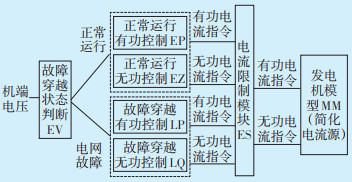
|
| 图 1 双馈风电机组故障穿越控制模型框图 Figure 1 Fault ride-through control model for double-fed wind turbines |
电网正常运行时,有功电流指令和无功电流指令通过EP和EZ模块输出。当电网发生故障时,EV会根据机端实时电压判断是否进入低电压过渡(简称低穿),风电机组低穿要求见图 2,如果机端电压进入国标要求的低穿范围内,则由LP和LQ模块输出有功和无功电流指令。
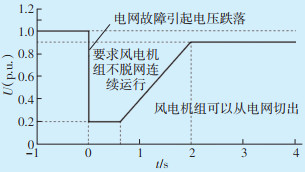
|
| 图 2 风电机组低穿要求 Figure 2 Low voltage ride-through requirements for wind turbines |
LP模块为风机故障穿越期间的有功控制模块,参照三段式故障穿越模拟方法(见图 3),该模块可设置故障期间的有功控制模式、有功恢复起点控制模式和有功恢复过程控制模式。
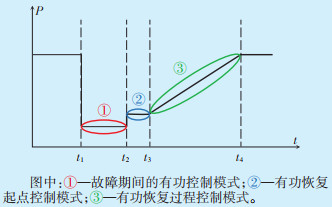
|
| 图 3 三段式故障穿越模拟方法(有功功率) Figure 3 Three-stage fault ride-through simulation method (active power) |
常用的故障期间的有功控制模式包括指定有功功率模式和指定有功电流模式。指定有功功率模式为:

|
(1) |
式中:Pr为模型输出的有功功率参考值;KP为系数;P0为初始有功功率;PS为故障期间的有功功率控制值。
指定有功电流模式为:

|
(2) |
式中:IPr为模型输出的有功电流参考值;KV、KI为系数;Vt为端电压幅值;IP0为初始有功电流;IPS为故障期间的有功电流控制值。
常用的故障恢复起点控制模式包括指定故障期间有功电流和指定故障期间有功功率模式。指定故障期间有功电流模式为:

|
(3) |
故障期间的有功恢复过程控制模式包括指定斜率恢复模式和按惯性曲线恢复模式。
1.2.2 无功控制LQ模块为风机故障穿越期间的无功控制模块,参照三段式故障穿越模拟方法(见图 4),该模块可设置故障期间的无功控制模式、无功恢复起点控制模式和无功恢复过程控制模式。故障期间的无功控制模式包括指定无功功率模式和指定无功电流模式,但因国标中明确提出了风电机组在故障穿越期间向电网提供无功电流支撑的要求,风机厂商一般会将风机的无功控制模式默认设置为指定无功电流模式,即:
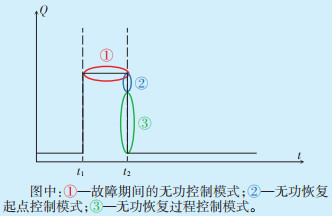
|
| 图 4 三段式故障穿越模拟方法(无功功率) Figure 4 Three-stage fault ride-through simulation method (reactive power) |

|
(4) |
式中:IQr为模型输出的无功电流参考值;VS为进入故障穿越状态的电压判据值;IQ0为初始无功电流;IQS为故障期间的无功电流控制值。
2 双馈风电机组故障穿越特性为了解双馈风电机组在故障穿越期间的实际特性,将双馈风电机组实物控制器接入RT-LAB硬件在环仿真平台,通过数模混合仿真的方式开展故障穿越实测工作[33-34]。风机初始功率为0.986(p.u.),模拟三相电压跌落对称故障,按照表 1所示故障深度和持续时间设置故障点,测试结果如图 5—7所示。
| 表 1 模拟故障点参数设置 Table 1 Parameters setting of simulation fault point |

|
| 图 5 故障期间有功功率、无功功率、有功电流、无功电流随电压跌落深度变化趋势 Figure 5 Variation trend of active power, reactive power, active current and reactive current with voltage drop depth during fault period |
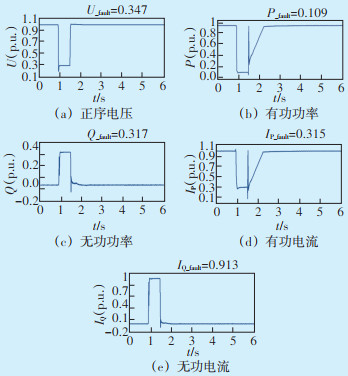
|
| 图 6 故障电压跌落深度设置为20%时的实测结果 Figure 6 Measured results when the drop depth of fault voltage is set to 20% |
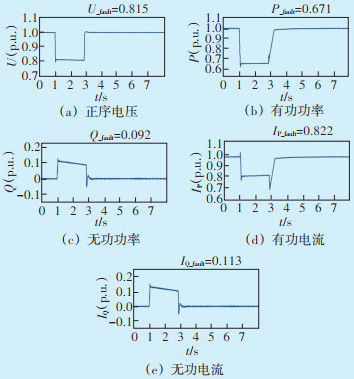
|
| 图 7 故障电压跌落深度设置为0.8(p.u.)时的实测结果 Figure 7 Measured results when the drop depth of fault voltage is set to 0.8(p.u.) |
根据图 5(b)和图 5(d)判断,风机在低电压过渡时期的无功控制应为指定无功电流模式,即按式(4)运行计算。仿真时取KV=1.680,VS=0.900,KI=0,IQS=-63.2 A,仿真与实测结果对比如图 8和图 9所示。
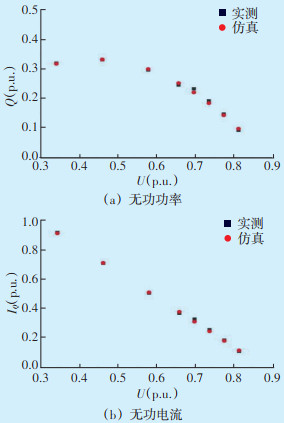
|
| 图 8 不同电压跌落深度下无功控制仿真与实测结果对比 Figure 8 Comparison of simulation and measured results of reactive power control under different voltage drop depths |
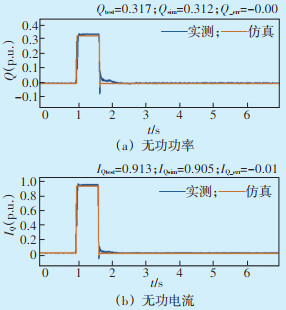
|
| 图 9 故障电压跌落深度设置为0.2(p.u.)时无功控制仿真与实测结果对比 Figure 9 Comparison of simulation and measured results of reactive power control when the drop depth of fault voltage is set to 0.2(p.u.) |
由图 8和图 9可知,按照指定无功电流模式设置的参数进行仿真后,仿真与实测结果基本吻合,因此可确认风机发生低电压穿越时的无功控制模式应为指定无功电流模式,符合国家标准要求。
3.2 有功控制模式根据图 5(a)和图 5(c)判断,风机在不同的电压跌落范围内存在不同的有功控制模式,且在故障电压跌落深度为0.7(p.u.)时存在明显的分界点。因此,需要在0~0.7(p.u.)和0.7(p.u.)~0.9(p.u.)两个范围内辨识其有功控制模式及参数。风机的有功控制模式输出为有功电流指令,且BPA双馈风机模型中也将发电机简化为电流源,因此优先考虑风机低电压穿越期间的有功控制模式为指定有功电流模式,即按照式(2)运行计算。仿真时取KV=0,KI=0.440,IPS=-158 A,故障电压范围为0~0.7(p.u.)的仿真与实测结果对比如图 10和11所示。
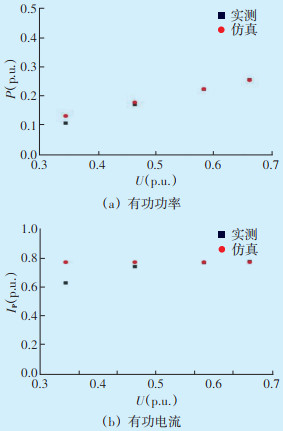
|
| 图 10 0~0.7(p.u.)电压跌落深度时有功控制仿真与实测结果对比 Figure 10 Comparison of simulation and measured results of active power control when the drop depth of voltage is from 0 to 0.7(p.u.) |
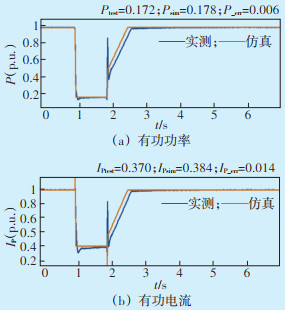
|
| 图 11 故障电压跌落深度设置为0.35(p.u.)时有功控制仿真与实测结果对比 Figure 11 Comparison of simulation and measured results of active power control when the drop depth of fault voltage is set to 0.35(p.u.) |
由图 10和11可知,按照指定有功电流模式设置的参数进行仿真后,其仿真与实测结果基本吻合,因此风机在0~0.7(p.u.)电压范围内发生低电压过渡时的有功控制模式应为指定有功电流模式。另外,风机在故障结束后的有功恢复阶段,观察其故障曲线可知,故障结束后有功功率并非立即恢复,而是从某一起点开始以一定斜率恢复,因此仿真时预设其恢复起点控制为指定有功电流模式,取KI=0,IPS=2230 A,恢复过程控制为指定斜率恢复模式,取斜率0.85,仿真与实测结果基本吻合。
当故障电压在0.7(p.u.)~0.9(p.u.)时,式(2)中取KV=0,KI=0.790,IPS=126 A;有功恢复阶段预设其恢复起点控制为指定有功电流模式,式(3)中取KI=0,IPS=2650 A;恢复过程控制为指定斜率恢复模式,取斜率0.85。故障电压在0.7(p.u.)~0.9(p.u.)的仿真与实测结果对比如图 12和13所示。可见,按照指定有功电流模式设置的参数进行仿真后,其仿真结果与实测结果基本吻合,因此风机在0.7(p.u.)~0.9(p.u.)电压范围内发生低电压过渡时的有功控制模式也应为指定有功电流模式,在有功恢复阶段的起点及过程控制模式也与0~0.7(p.u.)范围内的控制模式类似,仅是参数略有不同。
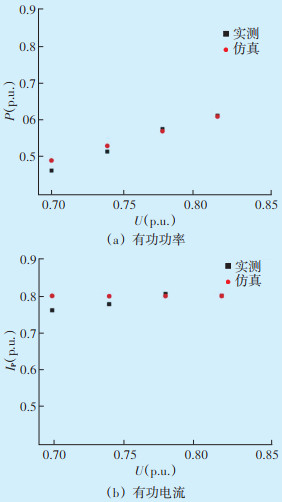
|
| 图 12 0.7(p.u.)~0.9(p.u.)电压跌落深度时有功控制仿真与实测结果对比 Figure 12 Comparison of simulation and measured results of active power control when the drop depth of voltage is from 0.7(p.u.) to 0.9(p.u.) |
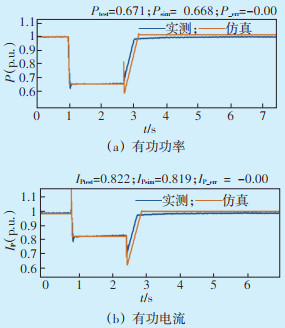
|
| 图 13 故障电压跌落深度设置为0.8(p.u.)时有功控制仿真与实测结果对比 Figure 13 Comparison of simulation and measured results of active power control when the drop depth of fault voltage is set to 0.8(p.u.) |
此外,观察图 10(b)和图 12(b)中IP的仿真值与实测值,在电压跌落深度较深时,仿真值会大于实测值。这是因为该风机内置的控制逻辑为无功优先,即优先满足风机在低电压过渡期间的无功功率输出需求。在风机实际运行中,有功和无功电流除受到电流限制模块ES限制外,有功电流IP还受到
本文对某双馈风电机组不同电压跌落深度下的低电压过渡特性进行了硬件在环测试,结果表明,在低电压过渡期间的无功控制模式为指定无功电流模式;有功控制模式为指定有功电流模式,但在0~0.7(p.u.)和0.7(p.u.)~0.9(p.u.)故障电压范围内对应两套不同参数。根据以上分析结论进行建模仿真,仿真与实测结果基本吻合,能够更加准确地反映风机的实际特性。但现有的BPA版本中,暂时还无法实现在单个风机模型内根据需求切换控制模式,因此对于本文所讨论的风机,在机电暂态建模工作中需要额外说明其在不同故障电压范围内的不同表现。
| [1] |
解振华.
中国低碳发展宏观战略研究总报告[M]. 北京: 人民出版社, 2017.
(  0) 0)
|
| [2] |
于贵瑞, 郝天象, 朱剑兴. 中国碳达峰、碳中和行动方略之探讨[J].
中国科学院院刊, 2022, 37(4): 423-434 YU Guirui, HAO Tianxiang, ZHU Jianxing. Discussion on Action Strategies of China's Carbon Peak and Carbon Neutrality[J]. Bulletin of Chinese Academy of Sciences, 2022, 37(4): 423-434 (  0) 0)
|
| [3] |
国网能源研究院有限公司.
中国能源电力发展展望(2020)[M]. 北京: 中国电力出版社, 2020.
(  0) 0)
|
| [4] |
舒印彪, 张丽英, 张运洲, 等. 我国电力碳达峰、碳中和路径研究[J].
中国工程科学, 2021, 23(6): 1-14 SHU Yinbiao, ZHANG Liying, ZHANG Yunzhou, et al. Carbon peak and carbon neutrality path for China's power industry[J]. Strategic Study of CAE, 2021, 23(6): 1-14 (  0) 0)
|
| [5] |
谢小荣, 贺静波, 毛航银, 等. "双高" 电力系统稳定性的新问题及分类探讨[J].
中国电机工程学报, 2021, 41(2): 461-474 XIE Xiaorong, HE Jingbo, MAO Hangyin, et al. New Issues and classification of power system stability with high shares of renewables and power electronics[J]. Proceedings of the CSEE, 2021, 41(2): 461-474 (  0) 0)
|
| [6] |
张智刚, 康重庆. 碳中和目标下构建新型电力系统的挑战与展望[J].
中国电机工程学报, 2022, 42(8): 2806-2819 ZHANG Zhigang, KANG Chongqing. Challenges and Prospects for Constructing the New-type Power System Towards a Carbon Neutrality Future[J]. Proceedings of the CSEE, 2022, 42(8): 2806-2819 DOI:10.13334/J.0258-8013.PCSEE.220467 (  0) 0)
|
| [7] |
何世恩, 董新洲. 大规模风电机组脱网原因分析及对策[J].
电力系统保护与控制, 2012, 40(1): 131-137 HE Shien, DONG Xinzhou. Cause analysis on large-scale wind turbine tripping and its countermeasures[J]. Power System Protection and Control, 2012, 40(1): 131-137 DOI:10.3969/j.issn.1674-3415.2012.01.023 (  0) 0)
|
| [8] |
孙华东, 许涛, 郭强, 等. 英国"8·9" 大停电事故分析及对中国电网的启示[J].
中国电机工程学报, 2019, 39(21): 6183-6192 SUN Huadong, XU Tao, GUO Qiang, et al. Analysis on Blackout in Great Britain Power Grid on August 9th, 2019 and Its Enlightenment to Power Grid in China[J]. Proceedings of the CSEE, 2019, 39(21): 6183-6192 (  0) 0)
|
| [9] |
曾辉, 孙峰, 李铁, 等. 澳大利亚"9·28" 大停电事故分析及对中国启示[J].
电力系统自动化, 2017, 41(13): 1-6 ZENG Hui, SUN Feng, LI Tie, et al. Analysis of "9·28" Blackout in South Australia and Its Enlightenment to China[J]. Automation of Electric Power Systems, 2017, 41(13): 1-6 DOI:10.7500/AEPS20170120002 (  0) 0)
|
| [10] |
易俊, 卜广全, 郭强, 等. 巴西"3·21" 大停电事故分析及对中国电网的启示[J].
电力系统自动化, 2019, 43(2): 1-6 YI Jun, BU Guangquan, GUO Qiang, et al. Analysis on Blackout in Brazilian Power Grid on March 21, 2018 and Its Enlightenment to Power Grid in China[J]. Automation of Electric Power Systems, 2019, 43(2): 1-6 (  0) 0)
|
| [11] |
李明节, 于钊, 许涛, 等. 新能源并网系统引发的复杂振荡问题及其对策研究[J].
电网技术, 2017, 41(4): 1035-1042 LI Mingjie, YU Zhao, XU Tao, et al. Study of complex oscillation caused by renewable energy integration and its solution[J]. Power System Technology, 2017, 41(4): 1035-1042 (  0) 0)
|
| [12] |
中国电力企业联合会. 风电场接入电力系统技术规定第1部分: 陆上风电: GB/T 19963.1-2021[S]. 北京: 中国标准出版社, 2021.
(  0) 0)
|
| [13] |
郭琦, 卢远宏. 新型电力系统的建模仿真关键技术及展望[J].
电力系统自动化, 2022, 46(10): 18-32 GUO Qi, LU Yuanhong. Key Technologies and Prospects of Modeling and Simulation of New Power System[J]. Automation of Electric Power Systems, 2022, 46(10): 18-32 (  0) 0)
|
| [14] |
陈垣, 张波, 谢帆, 等. 电力电子化电力系统多时间尺度建模与算法相关性研究进展[J].
电力系统自动化, 2021, 45(15): 172-183 CHEN Yuan, ZHANG Bo, XIE Fan, et al. Research Progress of Interrelationship Between Multi-time-scale Modeling and Algorithm of Power-electronized Power System[J]. Automation of Electric Power Systems, 2021, 45(15): 172-183 (  0) 0)
|
| [15] |
张兴, 孙艳霞, 李丽娜, 等. 风电机组电磁暂态建模及验证[J].
中国电力, 2020, 53(7): 106-112 ZHANG Xing, SUN Yanxia, LI Lina, et al. Electromagnetic Transient Modelling and Verifying of Wind Turbine Generator[J]. Electric Power, 2020, 53(7): 106-112 (  0) 0)
|
| [16] |
刘栋, 唐绍普, 胡祥楠, 等. 电力系统基础仿真算法对比分析研究[J].
全球能源互联网, 2018, 1(2): 137-143 LIU Dong, TANG Shaopu, HU Xiangnan, et al. The Comparison and Study of Fundamental Algorithms in Power System Simulation[J]. Journal of Global Energy Interconnection, 2018, 1(2): 137-143 (  0) 0)
|
| [17] |
能源行业风电标准化技术委员会风电场并网管理分技术委员会. 风电机组电气仿真模型验证规程: NB/T 31053-2021[S]. 北京: 中国电力出版社, 2021.
(  0) 0)
|
| [18] |
汤涌, 卜广全, 印永华, 等. PSD-ST暂态稳定程序用户手册5.8版[R]. 北京: 中国电力科学研究院, 2021.
(  0) 0)
|
| [19] |
卓振宇, 张宁, 谢小荣, 等. 高比例可再生能源电力系统关键技术及发展挑战[J].
电力系统自动化, 2021, 45(9): 171-191 ZHUO Zhenyu, ZHANG Ning, XIE Xiaorong, et al. Key technologies and developing challenges of power system with high proportion of renewable energy[J]. Automation of Electric Power Systems, 2021, 45(9): 171-191 (  0) 0)
|
| [20] |
李亚楼, 张星, 胡善华, 等. 含高比例电力电子装备电力系统安全稳定分析建模仿真技术[J].
电力系统自动化, 2022, 46(10): 33-42 LI Yalou, ZHANG Xing, HU Shanhua, et al. Modeling and Simulation Technology for Stability Analysis of Power System with High Proportion of Power Electronics[J]. Automation of Electric Power Systems, 2022, 46(10): 33-42 (  0) 0)
|
| [21] |
高峰, 周孝信, 朱宁辉, 等. 直驱式风电机组机电暂态建模及仿真[J].
电网技术, 2011, 35(11): 29-34 GAO Feng, ZHOU Xiaoxin, ZHU Ninghui, et al. Electromechanical Transient Modeling and Simulation of Direct-Drive Wind Turbine System With Permanent Magnet Synchronous Generator[J]. Power System Technology, 2011, 35(11): 29-34 (  0) 0)
|
| [22] |
杨旼才, 余建峰, 欧阳金鑫, 等. 电网故障下永磁直驱风电机组机电暂态全过程等值建模方法[J].
电工电能新技术, 2021, 40(5): 22-33 YANG Mincai, YU Jianfeng, OUYANG Jinxin, et al. Equivalent modeling method of whole electromechanical transient state of permanent magnet direct-drive wind turbine under grid fault[J]. Advanced Technology of Electrical Engineering and Energy, 2021, 40(5): 22-33 (  0) 0)
|
| [23] |
潘学萍, 温荣超, 鞠平, 等. 双馈风电机组网侧控制器参数辨识的频域方法[J].
电网技术, 2015, 39(3): 634-638 PAN Xueping, WEN Rongchao, JU Ping, et al. A Frequency-Domain Based Method to Identify Parameters of Grid Side Converter Controller for Doubly Fed Induction Generators[J]. Power System Technology, 2015, 39(3): 634-638 (  0) 0)
|
| [24] |
何廷一, 李胜男, 黄伟, 等. 基于实测参数辨识的双馈风机机电暂态建模研究[J].
云南电力技术, 2020, 48(2)99-102, 110 HE Tingyi, LI Shengnan, HUANG Wei, et al. Parameter Identificantion Method of DFIG Electromechanical Transient Modeling Based on Measured Data[J]. Yunnan Electric Power, 2020, 48(2)99-102, 110 (  0) 0)
|
| [25] |
田新首. 大规模双馈风电场与电网交互作用机理及其控制策略研究[D]. 北京: 华北电力大学, 2016.
(  0) 0)
|
| [26] |
胡宏彬, 丛雨, 翟寅, 等. 1.5 MW永磁直驱式风电机组控制系统仿真分析[J].
内蒙古电力技术, 2020, 38(4): 32-36 HU Hongbin, CONG Yu, ZHAI Yin, et al. Simulation Analysis of Control System for 1.5 MW Permanent Magnet Direct Drive Wind Turbine[J]. Inner Mongolia Electric Power, 2020, 38(4): 32-36 (  0) 0)
|
| [27] |
王辉, 王艺霏, 王姗姗, 等. 基于动态电压指令值变化的双馈异步风力发电系统高低电压穿越控制策略[J].
高电压技术, 2022, 48(9): 3680-3688 WANG Hui, WANG Yifei, WANG Shanshan, et al. High-and Low-voltage Ride-through Control Strategy for DFIG Wind Power System Based on Variable Dynamic Voltage Command Value[J]. High Voltage Engineering, 2022, 48(9): 3680-3688 (  0) 0)
|
| [28] |
李雨龙, 袁旭峰, 陈瑞洁, 等. 计及无功补偿的双馈风机低电压穿越技术[J].
电网与清洁能源, 2021, 37(9)100-107, 117 LI Yulong, YUAN Xufeng, CHEN Ruijie, et al. Low Voltage Ride Through Technology of DFIG Considering Reactive Power Compensation[J]. Advances of Power System & Hydroelectric Engineering, 2021, 37(9)100-107, 117 (  0) 0)
|
| [29] |
姜惠兰, 王绍辉, 贾燕琪, 等. 基于定子电流微分前馈控制的双馈异步风力发电机低电压穿越复合控制策略[J].
高电压技术, 2021, 47(1): 198-204 JIANG Huilan, WANG Shaohui, JIA Yanqi, et al. Low Voltage Ride-through Compound Control Strategy of Doubly-fed Induction Generator Based on Stator Current Differential Feedforward Control[J]. High Voltage Engineering, 2021, 47(1): 198-204 (  0) 0)
|
| [30] |
欧阳金鑫, 唐挺, 郑迪, 等. 低电压穿越控制下双馈风电机组短路电流特性与计算方法[J].
电工技术学报, 2017, 32(22): 216-224 OUYANG Jinxin, TANG Ting, ZHENG Di, et al. Characteristics and Calculation Method of Short-Circuit Current of Doubly Fed Wind Generator under Lower Voltage Ride Through[J]. Transactions of China Electrotechnical Society, 2017, 32(22): 216-224 (  0) 0)
|
| [31] |
能源行业风电标准化技术委员会. 风电机组电气仿真模型建模导则: NB/T 31066-2015[S]. 北京: 中国电力出版社, 2016.
(  0) 0)
|
| [32] |
孔旻玥. 双馈风电机组并网运行控制系统参数辨识技术研究[D]. 杭州: 浙江大学, 2022.
(  0) 0)
|
| [33] |
王立强, 曹斌, 王琪, 等. 基于RT-LAB的双馈风电机组建模与仿真[J].
内蒙古电力技术, 2020, 38(4): 43-46 WANG Liqiang, CAO Bin, WANG Qi, et al. Modeling and Simulation of Doubly Fed Wind Turbine Based on RT-LAB[J]. Inner Mongolia Electric Power, 2020, 38(4): 43-46 (  0) 0)
|
| [34] |
王立强, 曹斌, 丛雨, 等. 基于RT-LAB的SVG电网适应性仿真评估[J].
内蒙古电力技术, 2021, 39(2): 20-24 WANG Liqiang, CAO Bin, CONG Yu, et al. Grid Adaptability Simulation Evaluation of SVG Based on RT-LAB[J]. Inner Mongolia Electric Power, 2021, 39(2): 20-24 (  0) 0)
|
 2023, Vol. 41
2023, Vol. 41


